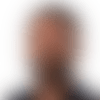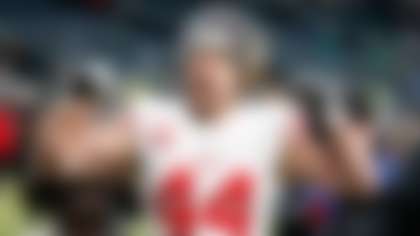After building their rosters over the last few months, all 32 teams possess at least one concern heading into the 2018 season. Now that we're post-draft, let's take a look at some summer subplots. Today, Jeremy Bergman examines one burning question for each AFC team.
AFC EAST
Buffalo Bills: Is AJ McCarron assured the starting QB job?
You wouldn't know it by the roster in Buffalo -- or by the moves general manager Brandon Beane has been making -- but the Bills just broke a 17-year postseason drought last season. Unfortunately, within five months of losing ugly in Wild Card Weekend, Buffalo's playoff prospects for 2018 look even uglier. The weakest position group on the Bills' depth chart is the offensive line, which lost three starters, but the most fascinating one is under center. Only one quarterback on the roster (Nathan Peterman) was on the team in 2017, and he threw five picks in his first half as a starter. McCarron (acquired in free agency) and Josh Allen (drafted seventh overall) are considered the bridge and future, respectively. McCarron has done little to prove that he is a starting-caliber quarterback, and his slow-as-molasses market in free agency showed that the league didn't think that highly of him, either. Allen is considered a raw prospect who's all arm and no aim, but if the rookie puts together a dynamite preseason, would Buffalo consider tossing Allen into the fire? Since 2010, only three quarterbacks drafted in the top 10 have failed to start at least 12 games in their rookie year: Patrick Mahomes, Jared Goff and Jake Locker. Allen's no sure thing, but neither is the "veteran presence" brought in to bridge the gap. That's a recipe for early-season snaps.
Miami Dolphins: If this team doesn't turn it around in 2018, is it Adam Gase's fault?
We're two seasons into the Adam Gase experiment in Miami, and the Dolphins are still breaking even: 10-6 with a postseason berth one year, 6-10 on the Jay Cutler roller coaster the next. Miami's reputation as a milquetoast, middling operation has so far held in the Gase era, but this offseason, the straight-shooting coach shook it up a bit. Gone are Ndamukong Suh, Jarvis Landry, Julius Thomas and Mike Pouncey, all victims of a roster purge in the name of CULTURE FIT. In Landry's stead, Miami sought out similar skill sets, lighter on the skill, in Danny Amendola and Albert Wilson. Suh switched locales with edge rusher Robert Quinn; Thomas has been replaced by blue-chip rookie Mike Gesicki; and Miami traded for Daniel Kilgore to fill in for Pouncey. The Dolphins' reshaping is completely of Gase's design, but will it produce a winner? If not, perhaps the problem isn't the players on the roster, but the man who's coaching them.
New England Patriots: Is the offensive line fine after replacing Nate Solder with a rookie?
The existential worries in Foxborough this offseason revolved around the decline of the empire: a potential schism between Tom Brady and Bill Belichick here, Rob Gronkowski retirement rumors there. But there are more pressing issues with the Pats than the #EndOfAnEra, namely on the offensive line. After losing LT Nate Solder -- and his 1,114 regular-season snaps -- in free agency, New England has question marks at both tackle positions, considering RT Marcus Cannon is still recovering from ankle surgery that prematurely ended his 2017 season. Isaiah Wynn, a first-round rookie out of Georgia, is pegged to start in Solder's place -- but many thought he would be moving to guard in the NFL, and at 6-foot-2, the newbie is way undersized compared to his predecessor. The other options at left tackle include last year's right tackle fill-in, LaAdrian Waddle, and former Niners tackle Trent Brown. The last thing Brady needs entering his age 41 season is uncertainty on the offensive line, especially on his blind side. Will veteran O-line coach Dante Scarnecchia have his unit figured out by the end of training camp?
New York Jets: Is 20-year-old Sam Darnold ready now to lead this franchise out of the desert?
Joe Namath played his final game for the Jets during the final days of the Ford administration. It's been two score and two years since New York had a bona fide, without-a-doubt franchise quarterback in its ranks. So, what's another five months of waiting, right? Wrong. After a passable performance during rookie minicamp, the chatter surrounding Darnold starting Week 1 for the Jets has grown into full-blown reports. The club's stateside owner didn't do anything to quell the hype around his franchise QB, saying that people will look back on Gang Green's decision to draft Darnold as the moment "that they became a great team." Promising inevitable greatness upon unfounded evidence is all the rage these days, but are we sure the Jets should accelerate Darnold's ascension to the starting role (and, in doing so, the Jets' ascension to the ranks of the relevant)? New York spent a good amount of dollars this offseason bringing back Josh McCown -- and reeled in Teddy Bridgewater at a discount -- to provide mentorship and rookie insurance for Darnold. Unless the rook overperforms in the preseason and demonstrates an outstanding grasp of Jeremy Bates' system, it would be wasteful to not sit Darnold, who is a full voting age younger than McCown, behind the journeyman veteran in game situations for at least a quarter of the season. But Todd Bowles and Mike Maccagnan, who both have just two years left on their deals in Florham Park, don't have the luxury of time at their disposal.
AFC NORTH
Baltimore Ravens: Should Joe Flacco be worried?
A franchise long maligned in its early iterations by issues under center -- Jeff Blake, anyone? -- the Flacco-led Ravens have been pretty darn successful. Since being drafted in 2008, the quarterback has led Baltimore to the postseason six times, including five straight trips to start his career, and one Super Bowl title. But Ravens fans haven't seen playoff football since the 2014 season, and Flacco, wrought by injuries, immobility and unimaginative play calling, has seen the league pass him by. Baltimore boldly recognized this new normal when it traded up to select Lamar Jackson, regarded by Mike Vick as a Mike Vick in the making. With the Ravens"in the lab" cooking up ways to utilize Jackson's unique skill set, is Flacco a dead man walking in Charm City? Baltimore can opt out of Flacco's deal -- set to expire in 2022 -- with little penalty after the 2019 season, but the Ravens could choose to transition out of Cool Joe's ice-cold offense as early as training camp and include Jackson in newly instituted RPO-friendly plays starting in Week 1. Flacco won't be out the door "five minutes" from now, as Steve Smith teased on draft night, but his time in Baltimore is running out. How long Flacco has left is up to the rookie.
Cincinnati Bengals: With Tyler Eifert and John Ross healthy, will the offense return to '15 form?
It wasn't too long ago that the Bengals were one of the most complete teams in football, making the postseason in five straight years, the first five of Andy Dalton's pro career. But Cincy was bounced in the Wild Card Round each time, then fell off in 2016 and '17 thanks to the departures of some key pieces: wide receivers Mohamed Sanu and Marvin Jones, left tackle Andrew Whitworth and right guard Kevin Zeitler. Not to mention, tight end Tyler Eifert logged just 10 total games over the last two seasons. This has made the Red Rifle's job all the more difficult, significantly altering the Dalton Scale in the process. But Cincy has restocked itself in 2018. Eifert and "redshirt" rookie John Ross are healthy after lost 2017 seasons. Tyler Boyd is primed for a breakout year in the slot. To shore up the O-line, Cincy acquired veteran tackle Cordy Glenn and drafted in-state center Billy Price. Life appears easier these days for Dalton and seven-time Pro Bowl wideout A.J. Green, but will Cincy's roster moves translate to the football field?
Cleveland Browns: Will John Dorsey's offensive reshuffling pay off -- and what would that even look like?
On paper, the additions this spring of two former Pro Bowlers (Jarvis Landry in each of the past three years, Tyrod Taylor in 2015), two reliable running backs (Carlos Hyde, Nick Chubb) and a lightning-rod QB of the future (Baker Mayfield) signal that a massive offensive turnaround in Cleveland is due in September. But will the whole be greater than the sum of its parts? It depends on your expectations. The transfer of play-calling duties alone from Hue Jackson to Todd Haley, who is assuming "total autonomy" of the playbook, is enough to inspire optimism among fans longing for a creative, nuanced attack. But then again, any modified version of the Browns' offense would be better than what Cleveland mustered during that disgusting 1-31 stretch while quarterbacked by the likes of DeShone Kizer and Kevin Hogan. So, what are the markers for success in this new regime? A reshaped offensive line in 2017 couldn't keep Kizer from taking 38 sacks. (For the record, Taylor took 46 last year in Buffalo.) If Cleveland is middle of the road in sacks allowed, is that a success? The Browns haven't employed a 1,000-yard rusher since "Madden" cover child Peyton Hillis in 2010 (1,177). If Hyde, Chubb and Duke Johnson combine for even 1,500 yards, does that call for another dive into Lake Erie, this one celebratory? Does Tyrod need to outlast Baker through Week 12? Do Landry and Josh Gordon have to play nice? Due to all of the Dorsey-induced turnover, it's tough to tell whether the Browns are going for passable improvement or shooting for marked progress in 2017. Some are projecting Cleveland as a wild-card sleeper. Others would like those prognosticators to go the way of David Blatt. You know what? Let's start with securing a win and go from there.
Pittsburgh Steelers: Forget the middle-school drama at QB -- who's filling in for Ryan Shazier?
The very public squabble over mentoring responsibilities under center in Pittsburgh has distracted from the fact that, while the Steelers still have a very capable veteran quarterback on offense in Ben Roethlisberger, they do not have their quarterback on defense, Ryan Shazier. And that spells trouble for a Steelers unit that was last seen surrendering five touchdowns to an attack piloted by Blake Bortles. After the two-time Pro Bowl LB suffered a severe spinal injury in Week 13, Pittsburgh's run defense imploded with Vince Williams and Sean Spence left at ILB. Pittsburgh allowed the third-most rushing yards per attempt (5.07) after Shazier's injury (compared with 4.16 beforehand) and lost in the Divisional Round to the Jaguars. With Shazier out at least for the 2018 season, Pittsburgh will look to Williams and Jon Bostic to take up the mantle in the middle of the field. Who will fill the sizeable leadership void left by Shazier?
AFC SOUTH
Houston Texans: Is Deshaun Watson going to be the same?
WET-BLANKET ALERT. I don't want to stomp on all the good feelings that came out of Watson's abbreviated-but-raging rookie season and all the burgeoning optimism in Houston-area office spaces and fantasy circles that the Texans are set for seasons with a franchise quarterback of this era. (A leader under center who can evade the rush, throw the deep ball and scamper for first downs with equal ability -- and look poised doing so.) But let's not forget that, upon his return, Watson will have just overcome a season-ending ACL injury, a fate that tends to hamper mobile quarterbacks. I can't help but feel the specter of RGIII hanging over Watson's return to football. A high first-round pick like Watson, the dual-threat Griffin was named Offensive Rookie of the Year in 2012, a season that ended with a devastating knee injury that required reconstructive surgery. Griffin couldn't stay healthy following that and was out of Washington just three seasons after his dynamic rookie year. All the reports coming out of Houston's camp are positive, but as we learned from Indianapolis (more on them soon) last season, you can never be too sure about a team's handling of its most valuable commodity. Watson is the future in Houston and the face-to-be of the NFL ... as long as his knee holds up and his ROTY-worthy play continues. But that fate is far from guaranteed.
Indianapolis Colts: WILL ANDREW LUCK BE READY, or is this offense truly ready for his return?
Do we really have to explain this? Like, seriously? Does this website have to go into -- for the 384th time -- how the fate of Indianapolis' season and, more broadly, financial future resides on the organization's ability to get Andrew Luck and his capricious shoulder back on the damn field? This has been the only headline unrelated to that Foxborough-Based Coordinator Who Shall Not Be Named coming out of Lucas Oil Stadium over the past two seasons. It needs no further investigation. We're playing a sad waiting game until late July -- as are the rest of the Colts, who, during Luck's prolonged absence, have either moved on or stayed put. Donte Moncrief was replaced by Ryan Grant; Frank Gore by Marlon Mack and Nyheim Hines; and Jeremy Vujnovich by Quenton Nelson. Luck has been out of the picture for so long in Indianapolis that it's hard to remember how transcendent a talent he is and how he can pick up the rest of a roster. After over a year on the shelf, will the three-time Pro Bowl QB slide right back into form with a fresh cast of characters when -- er, if -- he returns to the fold?
Jacksonville Jaguars: On an otherwise-solid roster, how'll the bloated WR group shake out?
There was little to tinker with this offseason on Jacksonville's masterfully constructed roster (never thought I'd type those words in order), so the Jags loaded up on their strengths, signing guard Andrew Norwell and drafting defensive tackle Taven Bryan. But one region of the roster that remains still untamed is the receiving corps. With 2016 starters Allen Robinson and Allen Hurns outta there, the Jags are left with a WR group that runs 11 deep and is headlined by Marqise Lee and Colts castoff Donte Moncrief. Blake Bortles survived -- and at times, thrived -- last season with a ragtag WR corps, but the Jags' front office only rewarded him in free agency with Moncrief and tight end Austin Seferian-Jenkins. Behind Lee and Moncrief, who have plenty of starting experience, are a weedy cavalcade of backups (Keelan Cole, rookie D.J. Chark, Dede Westbrook, Rashad Greene, Jaydon Mickens). It's hard to make heads or tails of these WR3 wannabes, but as last season proved in Duval, the most unlikely of names can make the largest contributions down the stretch.
Tennessee Titans: Has Mike Vrabel successfully remade the defense in his own image?
Under Mike Mularkey, the Titans offense was identifiable by the nickname "Exotic Smashmouth," a catchy description that attempted (fruitlessly) to explain Mularkey's offensive philosophy of crash-and-dash football. The defense, on the other hand, had no nickname, which is to say it also had no identity under the offensive-minded skipper. First-year head coach Mike Vrabel is looking to change that. A linebacker by trade, Vrabel spent the offseason reshaping the Titans' defense. Tennessee started by signing Patriots persona-non-Super-Bowl-starta Malcolm Butler, despite already boasting two solid cornerbacks in Logan Ryan and Adoree' Jackson. Then, to replace the departed Avery Williamson, the Titans traded up in the draft to select two linebackers with their first two of just four picks: Alabama's Rashaan Evans and Boston College's Harold Landry. The acquisition of nose tackle Benny Logan also illustrates a desire -- between Vrabel and new Titans defensive coordinator Dean Pees -- to develop a more physical culture on Tennessee's defense.
AFC WEST
Denver Broncos: Can a quasi-youth movement renew relevance in an up-for-grabs division?
There are few questions that Denver's defense can rebound from a postseason-less January, despite the departure of Aqib Talib. The offense, on the other hand, underwent an extreme makeover this spring, infused in parts with wisdom and leadership and in other ways with a wave of youth. The replacement for the inexperienced Trevor Siemian under center, Minneapolis Miracle posterman Case Keenum (30 years old), is older than every other starter on Denver's offense except for his two wide receivers (Demaryius Thomas and Emmanuel Sanders) and tackle Jared Veldheer. All the while, John Elway has stocked the depth chart with late-millennial building blocks in second-year tackle Garett Bolles, rookie wideouts Courtland Sutton and DaeSean Hamilton, redshirt tight end Jake Butt and first-year tailback Royce Freeman. Denver's offense is a unit caught between two eras, that of the Lombardi-hoisting Peytonites and the Team That Elway Built. How those two cultures clash in 2018 will be a case study of Elway's ability to rebuild the franchise that reveres him.
Kansas City Chiefs: Will the reshuffled defense get it together?
All eyes will be on Patrick Mahomes' rocket arm and his loaded offensive talent pool next season, but Chiefs fans should spend more time worrying about the rapid dissolution of K.C.'s once rock-solid defense. This offseason, the Chiefs lost three leaders and 11 Pro Bowl appearances on that side of the ball, with the departures of Derrick Johnson, Tamba Hali and Marcus Peters. That doesn't even include the losses of reliable starting safety Ron Parker and cornerbacks Terrance Mitchell, Phillip Gaines and Darrelle Revis. The figurehead of the immense turnover on K.C.'s defense is inside linebacker Anthony Hitchens, who was brought over from Dallas to pair with Bills bust Reggie Ragland. The Chiefs hope they have a promising pairing on their hands in the middle of the front seven, but their honeymoon period will be short. For the first time in a long time last season, the defense was Kansas City's Achilles' heel, and while the Chiefs are reinventing the wheel on offense, they can't afford to be caught treading water on the other side of the ball.
Los Angeles Chargers: Where are the excuses?
The Chargers' first-year head coach is now a second-year coach. Their redshirted rookies (Mike Williams and Forrest Lamp) are healthy and in positions to start. With the addition of Derwin James, L.A.'s secondary will contend for best-in-the-league status. Plus, Younghoe Koo is not on the roster. In short, there are little-to-no excuses for the Chargers and their fan base to make in 2018. Every hole has been filled, or at least patched with a season's worth of Flex Seal. The Bolts' run defense (second-worst in the league in '17) is still suspect, but the additions of James (who also boasts playmaking ability against the run) and Uchenna Nwosu are expected to help in that regard. Other than that, you'll be hard-pressed to find reasons not to project the Chargers as the AFC West favorites, save for factors related to their sandbox sporting grounds or that intangible "Chargers curse." With Denver, K.C. and Oakland all in the midst of a transition, it's the Bolts' time to strike.
UPDATE: After the publishing of this article, tight end Hunter Henrysuffered a torn ACL in practice, furthering the Chargers' dismal run of bad injury luck.
Oakland Raiders: Has Jon Gruden been out of the game too long?
The Return of Chucky to the East Bay was a headline-grabbing hire that promised to provide SEO-friendly zingers and countless screen-captured memes. So far, Gruden's second go-around in Oakland has instead produced risky draft selections and questionable analytics philosophies. When Gruden said at the NFL Scouting Combine that he wanted to throw football back to 1998, he wasn't kidding. Oakland loaded up on backfield blockers in free agency by signing Lee Smith, Derek Carrier and Keith Smith to pair with Jared Cook. Gruden attempted to establish his "culture" by jettisoning Marquette King and Cordarrelle Patterson, despite their reputations as top-tier special teams aces. The new head coach also remade the receiving corps, replacing Michael Crabtree with Jordy Nelson, Martavis Bryant and Ryan Switzer, a motley crew with incongruous receiver traits. Draft experts said Oakland reached for an offensive lineman (Kolton Miller) in the first round with other needs on the board, took risks on question marks Arden Key and Maurice Hurst and failed to address the secondary until the fourth round. It's too early to presume how Gruden's Raiders will fare in 2018, but it's vital that, in taking these bold personnel and tactical risks, the coach doesn't go bust before the franchise even lands in Vegas.
Follow Jeremy Bergman on Twitter @JABergman.












